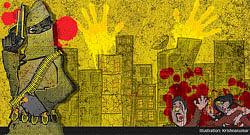Foes in our homes

This book, which studies the origin and growth of a home-grown terrorist network in India in the last two decades, has a special relevance after the serial explosions in Mumbai this month.
Investigations into the Mumbai outrage have pointed to the possibility of the attack having been planned and executed by persons within the country.
This is different from the usual knee-jerk response of blaming external agents for terrorist actions in the country. While terrorists born and trained outside the country have staged spectacular attacks, like the 26/11 Mumbai attack, Indians themselves were responsible for most such actions in Mumbai, New Delhi, Bangalore, Varanasi and many other places.
Therefore, it is important that we get a good understanding of the phenomenon of home-grown terrorism if we have to ensure that our cities, religious places, centres of social life and symbols of power are safe. Peace in society, economic progress and the country’s political strength depend much on this understanding, on how we address the resentment and grievances that give rise to native terrorism and on what we do at the level of policing and intelligence to deal with it.
This book will make a major contribution to that understanding. It is written by a journalist who has covered internal security, defence, diplomacy and strategic affairs for many years and has a close understanding of the events and issues in these areas.
He brings a journalist’s curiosity, a researcher’s eye for detail and hard work and an analyst’s perspective to the subject and opens a window to the world of terror within the country. Basically it is the story of the Indian Mujahideen, a terrorist group that rose and spread from the ultra-conservative Students Islamic Movement of India (SIMI), itself formed in 1977 as the student wing of the Jamaat-e-Islami.
While it is the sense of insecurity and grievances related to the socio-economic conditions of the majority of the Indian Muslims that led many young people to take to the extremist path, this would not have happened without wrong interpretations of religion and more importantly, without active involvement, encouragement and sponsorship from outside the country.
The writer relates homegrown terrorism to the international jihadist movement and looks at the roles played by Pakistan’s Inter-Services intelligence (ISI) and the links with groups like the Lashkar-e-Taiba and Al-Qaeda in nurturing the Indian groups. Even the testimonies of Pakistani double agent David Coleman Headley, which came out recently, are taken into consideration for the light it throws on the activities of Indian terrorists.
Almost every major terrorist action in India in the last many years is studied and there we get the profiles of the terrorists and their motivations and backgrounds in detail. A prodigious amount of minutiae about their movements, conversations and plans has been provided. The details have been taken from intelligence reports, police reports, charge-sheets, and a good part of the information is based on interviews with police and other sources. A lot of this data may not be interesting to the lay reader, but they are proof of the hard and meticulous work undertaken by the author.
What he finds is that most of the Indian Mujahideen terrorists, except for a hard core, are not of a religious fundamentalist bend of mind. He finds this a redeeming factor and rightly thinks that it gives an opportunity for the Indian leadership and security agencies to work on.
Failings by the state and inadequacies of response have worsened the problem. They are both political and administrative. All aspects of policing and security need improvement. Intelligence is often bad, policing is poor and the structure of the security establishment is faulty. Decisions are not always professional, and selection of personnel for crucial positions is made on personal considerations.
The suggestions made by the writer to counter the challenge of terrorism are not new. He observes that most terrorists had a poor background and had no employment prospects. Many of them wanted to avenge the demolition of the Babri Masjid and ill-treatment by official agencies, and resented the discrimination meted out to the community in many ways.
Most do not have a madrasa background. They became easy targets of indoctrination campaigns and were instigated and guided by forces outside the country. Improving the living conditions of the community is important to wean young members away from the militant path and make rebellion and violence unattractive for them.
The writer has also looked at the threat from ultra-right wing organisations of Hindu fundamentalists and mentioned incidents like the attacks on the Ajmer Sharif Dargah and Hyderabad’s Makkah Masjid and in Malegaon by Hindu fundamentalists.
He feels the threat from these organisations is also serious and cannot be described as stray incidents by misguided groups. But they figure only tangentially, since the writer’s attention is on studying the roots, growth and development of Islamic militancy in India.
A book is not all ideas and information. It is language too. The writer’s language is simple but he could have avoided the use of some wrong words, though there are not many of them.
Deccan Herald is on WhatsApp Channels| Join now for Breaking News & Editor's Picks